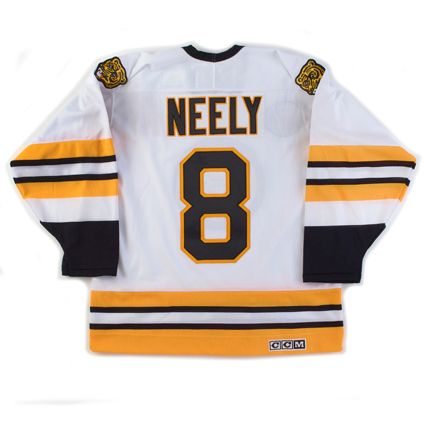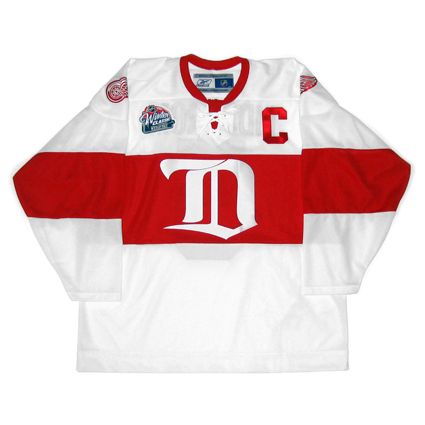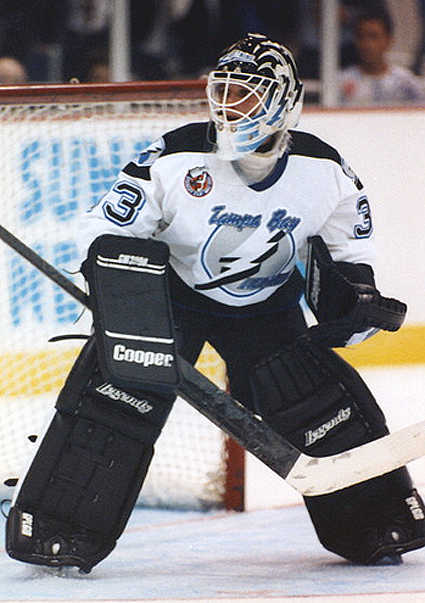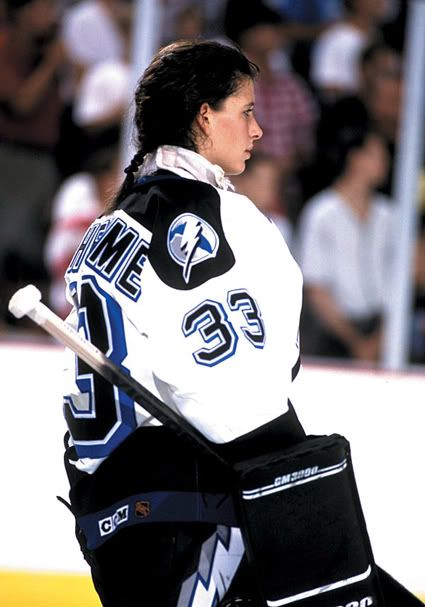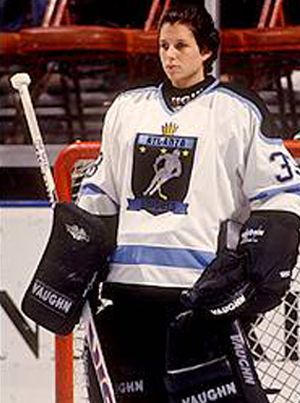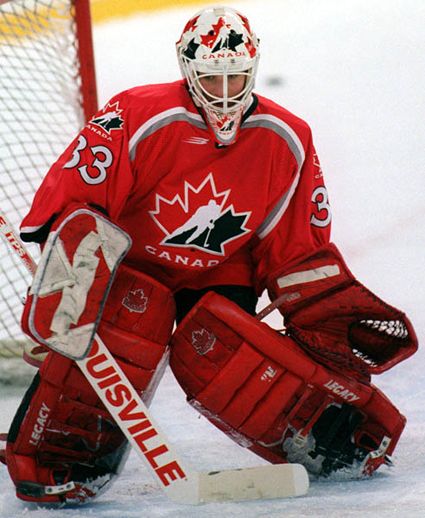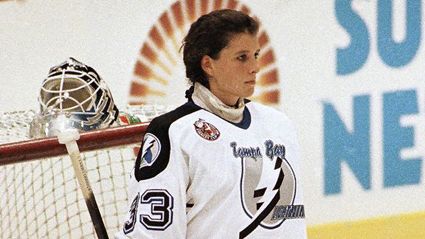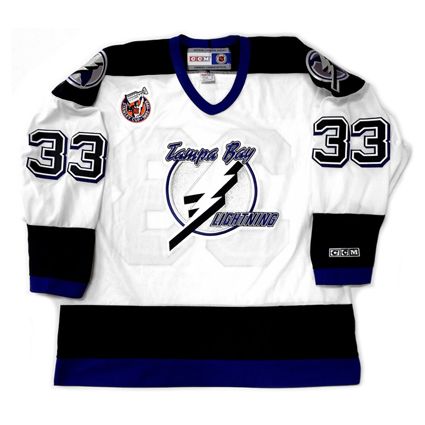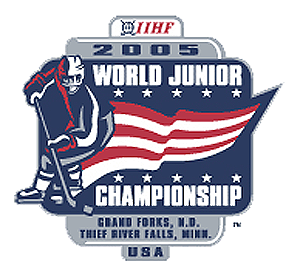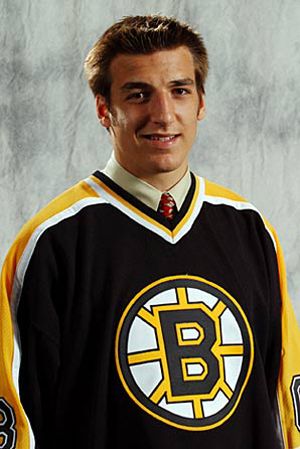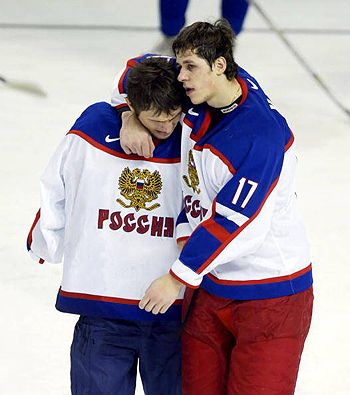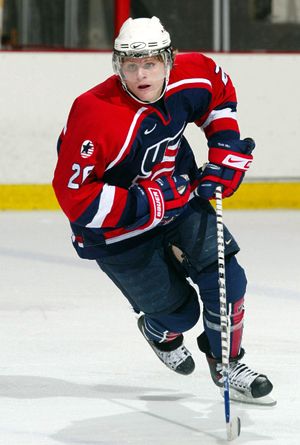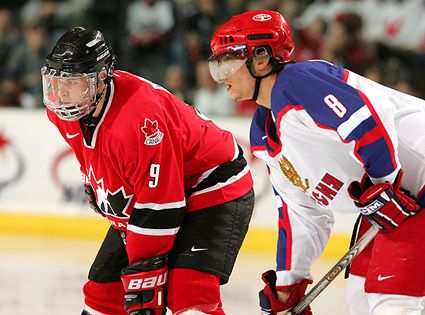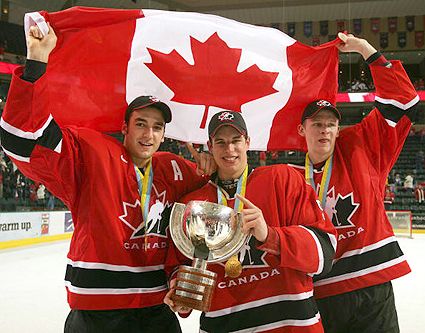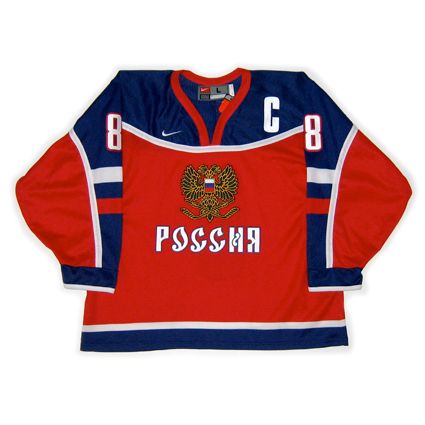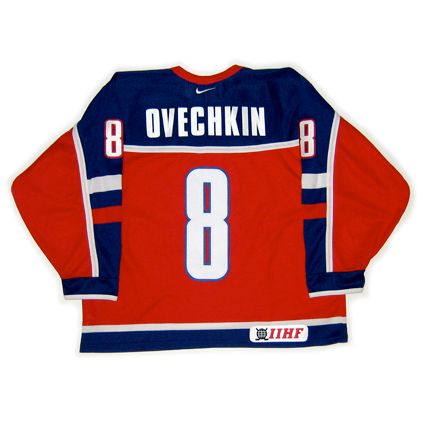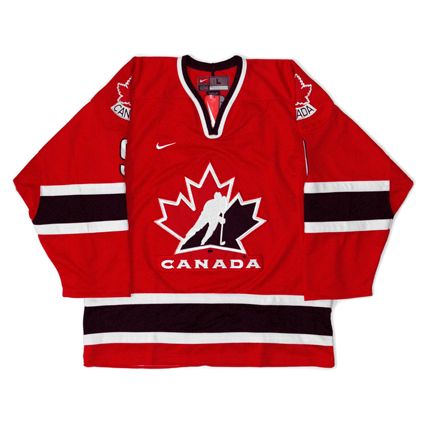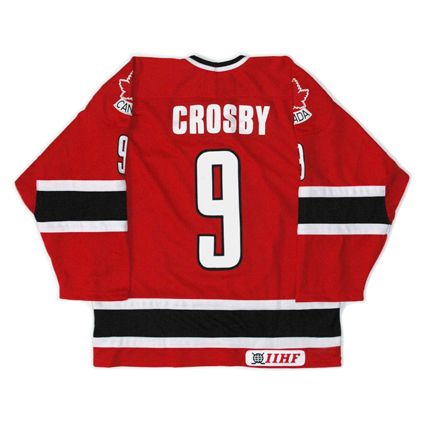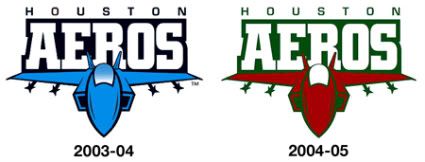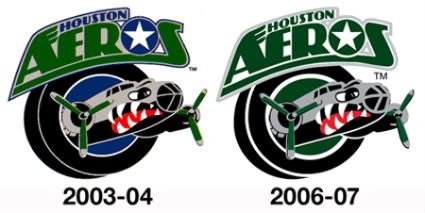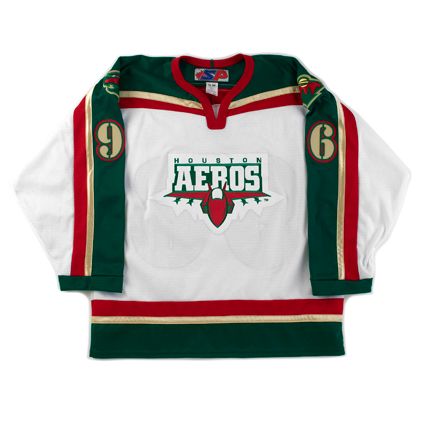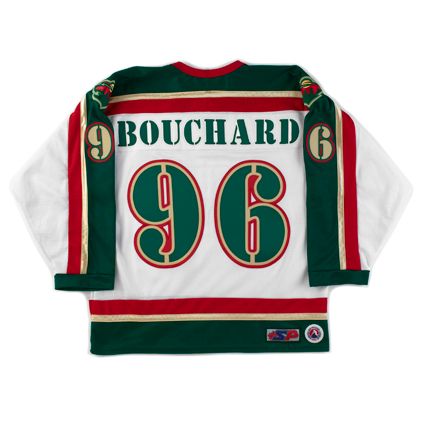Saturday, September 26, 2009
1995-96 Boston Bruins Cam Neely Jersey
The final game in Boston Garden was held when the Bruins hosted the Montreal Canadiens for a pre-season game on this date in 1995.
The Boston Garden opened on Novenber 17, 1928 and was designed by boxing promoter Tex Rickard, who also built the third Madison Square Garden in New York. It was originally called "Boston Madison Square Garden", which was later shortened to the "Boston Garden".
The Boston Garden was built on top of the a train station and was shared by the Boston Celtics basketball club.
Rickard built the arena with boxing in mind, believing that every seat should be close enough to see the "sweat on the boxers' brows". As a result, when the larger hockey surface was used, the fans were famously much closer to the action than in most arenas and it also led to a much louder and intimidating arena than the norm.
With the original design of the arena favoring boxing, it led to compromises with the playing surface for hockey, as it was nine feet shorter and two feet narrower than a now standard 200 feet by 85 feet. The arena was also without air conditioning, resulting in fog forming over the ice on occasion during spring playoff games.
The Boston Garden hosted the Stanley Cup Finals 16 times between 1929 and 1990, with the last two being interrupted by power outages at some point.
Eventually advances in architectural design and consumer demands meant that the 67 year old arena was in need of replacement. Along with no air conditioning, the seats were cramped and some had obstructed views due to pillars. It had less than 15,000 seats and no luxury boxes, a modern amenity that had become a major source of income for modern professional teams. With a new arena under construction in early 1993, the writing was on the wall for the old Boston Garden and the last event held in "The Gahden", was the preseason game between the Bruins and Canadiens, which was actually played in two 25-minute halves.
In a special post-game ceremony, the championship banners and retried numbers were removed with 30 former Bruins greats in attendance.
Today's featured jersey is a 1995-96 Boston Bruins Cam Neely jersey. Aside from being the classic Bruins jersey from one of the most popular Bruins ever, what sets this jersey apart is the "Last Hurrah" patch worn for the final game ever played in Boston Garden, fittingly won by the Bruins 3-0.
An awesome video treasury rounds out today's entry as we take a look back at the closing of the Boston Garden.
This is actually the first of 19 parts to this video series documenting the final game in Boston Garden and it's ceremonies. We have selected ones primarily relating to the history and ceremonies to post today.
After a pair of interviews with Bruins President and General Manager Harry Sinden and Canadiens Managing Director Serge Savard, Ed Westfall and Derek Sanderson take us for a tour of the arena, including a story about hunting rats while sitting on the bench(!) and a look at some of the more obstructed seats.
Starting halfway through this next segment is an extended interview with Bobby Orr.
Here are the notable Bruins alumni being introduced after the game starting four minutes into part 14, including the emotional return to the Boston Garden for Normand Leveille in part 15, whose career was cut short by a brain aneurysm early in his second season. It's a serious lineup of star players and classic jerseys (and sweaters), as each player wore the jersey style used during their first season with the club.
Part 16 includes the beginning of the players who have had their number retired by the Bruins, including Milt Schmidt.
This segment features Johnny Bucyk, Phil Esposito and an emotional Bobby Orr having their retired number banners lowered.
This final segment has the players taking one final skate around the ice, which must be seen just for the always classy Ray Bourque helping Normand Leveille take one final lap around the ice. It concludes with a nice highlight montage at the end.
Labels:
Boston Bruins,
Neely Cam
Friday, September 25, 2009
2008-09 Detroit Red Wings Nicklas Lidström Winter Classic Jersey
It was on this date in 1926 that the city of Detroit was granted an NHL franchise, which would be originally named the Detroit Cougars.
We know you saw this eleventy-billion times leading up to the game, but now that some time has passed, it's probably safe to view it once again because it is really well done.
When the Western Canada Hockey League folded after the 1925-26 season, a deal was made so that the new Detroit expansion club bought the rights to the players of one of the most successful of the WCHL teams, the 1925 Stanley Cup finalist Victoria Cougars.
The club was named the Cougars in the Victoria club's honor and actually played their first season across the Detroit River in Windsor, Ontario since they had no arena at the time. The Cougars played a 44 game schedule, finishing last in the American Division of the 10 team league with a 12-28-4 record. John Sheppard would lead the team in scoring with 21 points in 43 games.
The following year the Detroit Olympia would become their new home, where they would play for 52 years, until December of 1979. That same season Jack Adams would take over as coach and spend the next 36 years as either the coach or general manager of the club. The Cougars would finish the season with a 19-19-6 record for fourth place in the American Division. George Hay would lead the team with 35 points in 42 games, tied for third in the league.
he 1928-29 Cougars would finish with a similar 19-16-9 record, but make the Stanley Cup playoffs for the first time, losing out to the Toronto Maple Leafs 7-2 in a two game series. Carson Cooper would lead the Cougars in scoring with 27 points in 43 games to finish third in the league.
The final season for the name Cougars would see Detroit finish with a 14-24-5 record and miss out on the playoffs. Carson Cooper would again lead the team in scoring, this time with 36 points in 44 games played. For the next season the Detroit club would rename itself the Falcons.
Today's featured jersey is a Reebok 2008-09 Detroit Red Wings Nicklas Lidström jersey worn only for the Winter Classic on January 1, 2009 at Wrigley Field in Chicago when the Red Wings defeated the Chicago Blackhawks 6-4. Lidström had one assist in the game. This jersey features the Winter Classic patch, as worn on all players jerseys during the game.
This jersey is based on the style that Detroit wore in during the franchise's first season of 1926-27 when they were known by their original name of the Detroit Cougars.
Here is the NBC introduction to the game and the Canadian and US national anthems.
Finally, the start of the second period, which features the goal that Nicklas Lidström assisted on.
Labels:
Detroit Red Wings,
Lidstrom Nicklas,
Winter Classic
Thursday, September 24, 2009
Top 10 NHL Pre-Season Goals
Today is another one of those days on the calendar where nothing of great historical significance happened in hockey history, especially in relation to our hockey jersey collection.
Combine that with the fact we have to study for our Fantasy Hockey Draft this weekend, we don't have a jersey to post for today, but we will leave you with the Top 10 NHL Pre-Season Goals.
Be sure to check back tomorrow for a return to our usual format.
Labels:
humor
Wednesday, September 23, 2009
1992-93 Tampa Bay Lightning Manon Rheaume Jersey
On this date in 1992, Manon Rheaume became the first, and to this date only, woman to play in an NHL game.
Tampa Bay General Manager Phil Esposito explains how he first became aware of Rheaume: "I was up in Montreal looking at players and we went to this Junior A game and somebody said they wanted me to see this player. I saw the guy and I didn't think he was very good. I said "I like the little goalie." I didn't know it was a woman, and neither did my scout. I said, "I want to go talk to that goalie. He's got something." So I go down to talk to him and she walked out. I nearly flipped. I said, "Oh my God, she's gorgeous. Who is that girl?" They said, "That's the goalie."
Next, a feature "The Woman Behind the Mask" about her experience with the Lightning.
Tampa Bay General Manager Phil Esposito explains how he first became aware of Rheaume: "I was up in Montreal looking at players and we went to this Junior A game and somebody said they wanted me to see this player. I saw the guy and I didn't think he was very good. I said "I like the little goalie." I didn't know it was a woman, and neither did my scout. I said, "I want to go talk to that goalie. He's got something." So I go down to talk to him and she walked out. I nearly flipped. I said, "Oh my God, she's gorgeous. Who is that girl?" They said, "That's the goalie."
Rheaume was signed by the Tampa Bay Lightning, as an admitted publicity ploy, and played in the first period of the franchise's first home game, an exhibition game against the St. Louis Blues. She allowed two goals on nine shots, scored by Jeff Brown and Brendan Shanahan.
From Esposito's book "Thunder and Lightning", his take on her tryout with the Lightning;
During that training camp, I signed Manon Rheaume to come and play for us. Manon was a goaltender, and she was a beautiful young woman.I found Manon through Jacques Campeau. Jacques was the one who convinced me to sign Manon Rheaume. We went up to a women's tournament and watched her play. "Play her," he said. "The publicity will be great." I agreed with him. And so when we opened up camp in Lakeland, Manon was on the squad. As a result, CBS, NBC and ABC all were there talking about the first woman goaltender ever to play in an NHL game.Head coach Terry Crisp hated that Manon was on the team. So did my brother Assistant GM Tony Esposito, which may have been the only time they agreed on anything. Even Assistant Coach Wayne Cashman hated it. Cash would give me the evil eye. I'd say to him, "We're doing it. That's it." A lot of the scouts hated it too. They players didn't like it much either.I told Manon, "You have to go out with the guys. You have to be part of the team." They took her to dinner and for a few beers.I wanted to play her because there was nothing to lose and everything to gain. This wasn't Ottawa or Toronto or Boston or New York. This was Tampa, Florida. No other person would have even tried to start hockey here. I was the right guy at the right time to do this. Was in innovative? Some people thought so. Others thought it was crazy. I knew we weren't going to win, so my idea was to promote the team in any way I could to put people in the seats. If I had staked everything on the team's record, we would have had three thousand people in the building, and most of those would have been relatives.Manon wasn't a bad goalie, but she was gorgeous and too much of a model to stay in the game. There was no harm in letting her come to camp and play. When I told Crispy I wanted her to play half a game, he just about died."Oh no, we're a laughingstock as it is," he said."Terry, you are going to play her," I said. "And we're going to publicize it."Even though the players didn't want her to play, the all fought to room with her. We gave her her own dressing room.She played half a game against St. Louis during training camp at the Fairgrounds. The place was jammed. They were sitting up in the rafters. An unbelievable number of women came to that game. Brett Hull, who had one of the hardest shots in the game, was shooting bullets at her, and she stood right in there.Bobby Plager, the coach of the Blues, said to me, "I've instructed my boys to shoot at the five hole," meaning just below the crotch."Bobby, you pig," I said.During the game, Rob Ramage, one of our defensemen, an older guy, a class guy, wouldn't let any of the Blues players get near her. He was right there to protect her.During practice Manon pulled a muscle in her lower back. The trainer, Larry Ness, said to me, "What do I do?" I said, "You do the same as you'd do with a guy. But you better not get a hard-on."He was rubbing her back and her ass, and the guys were peeking through the curtain trying to see her naked.At the end of training camp, I sent her to Atlanta as the backup goalie for our International Hockey League team. She played once in a while and was okay. They ended up winning the championship. She went on to play on the 1998 Canadian Olympic team, which Canada lost to the United States. Manon made a good living speaking and signing autographs. They made a movie about her. Sure I exploited her, but it was good for her too.
While she did not make the Tampa Bay roster, she did play a pair of games for the Atlanta Knights of the IHL that season.
Rheaume also played in nine ECHL games spread between three clubs over the 1993-94 (Knoxville Cherokees - 4 games and the Nashville Knights - 4 games) and 1994-95 season (Tallahassee Tiger Sharks) , posting a 5-1-1 record.
She was also back in the IHL in 1994-95, playing in two games for the Las Vegas Thunder. Two seasons later, Rheaume was once again the pro ranks, appearing in 11 games for the Reno Renegades of the West Coast Hockey League with a 2-3-1 record.
She was also back in the IHL in 1994-95, playing in two games for the Las Vegas Thunder. Two seasons later, Rheaume was once again the pro ranks, appearing in 11 games for the Reno Renegades of the West Coast Hockey League with a 2-3-1 record.
By the time she reached the professional ranks, she was no stranger to competing with the boys, having become the first girl to play in the prestigious Quebec International Pee-Wee Hockey Tournament at age 11, as well as the first female to appear in the Quebec Major Junior Hockey League, seeing limited time in three games with the Trois-Rivieres Draveurs, totaling 17 minutes.
Aside from her forays into the world of men's hockey, she was also a very accomplished goaltender in the world of women's hockey, highlighted by winning gold medals at both the 1992 and 1994 World Championships for Canada, being named Tournament MVP both times. She then won a sliver medal at the 1998 Olympics in Nagano, Japan at the first women's Olympic hockey tournament.
Rheaume has written a well reviewed book about her experiences in hockey, titled Manon: Alone in Front of the Net.
Today's featured jersey is a 1992-93 Tampa Bay Lightning Manon Rheaume jersey. The jersey features the Stanley Cup Centennial patch worn on all NHL players' jerseys during the inaugural season for the Lightning.
While the jersey worn by the Lightning remained the same for 13 seasons through the 2006-07 season, the customization went through four distinct specifications. Their inaugural season of 1992-93 saw the team use a custom font for the names in three colors paired with a fairly standard block font for the numbers but with a drop shadow. The following season, saw both the names and numbers italicized.
In 1995-96, the team changed to a three color paintbrush font for the numbers and a vertically arched, bold block font for the names. Finally, in 2001-02, the team reverted back to their original font for the numbers, only now in three colors without a drop shadow paired with a simple one color block font for the names in what was a rather pedestrian look compared to the unique looks that preceded it.
In 1995-96, the team changed to a three color paintbrush font for the numbers and a vertically arched, bold block font for the names. Finally, in 2001-02, the team reverted back to their original font for the numbers, only now in three colors without a drop shadow paired with a simple one color block font for the names in what was a rather pedestrian look compared to the unique looks that preceded it.
In the video section today, plenty to view today. First, a report on Rheaume and her appearance for the Lightning.
Next, a feature "The Woman Behind the Mask" about her experience with the Lightning.
Here is a feature segment on Rheaume from her time on the Atlanta Knights, followed by her first appearance for the Knights, the first for a female in an IHL regular season game.
Next up is Rheaume's appearance on the David Letterman show, which must have been a bit nerve-wracking for a primarily French-speaking 20-year-old on national TV in the US.
Next is Rheaume's appearance on a Canadian Quiz show "Front Page Challenge", similar to "To Tell the Truth" or "What's My Line?" in the US, where a panel tries to guess the unusual occupation of a guest.
Labels:
Rheaume Manon,
Tampa Bay Lightning
Tuesday, September 22, 2009
2001-02 Wilkes-Barre/Scranton Penguins Mario Lemieux Jersey
On this date in 2001, Mario Lemieux played his one and only game in the minor leagues.
Lemieux suited up for the Wilkes-Barre/Scranton Penguins in an exhibition game in Wilkes-Barre versus their parent club, the Pittsburgh Penguins, which Pittsburgh won by a score of 4-2.
"I'll have to ask the coach what I did wrong," Lemieux joked.
Wikes-Barre team president Jeff Barrett said that the idea was a nice way to reward the minor league team's fans.
"I think it's going to be exciting to see me in a different uniform," said Lemieux. "I always wondered what it would be like to play against the Penguins. I'll have my chance on Saturday."
Lemieux wore three jerseys that night, one each period, which were then auctioned off for charity with the proceeds being donated to various charitable causes, including the Twin Towers Fund, organized following the terrorist attacks in New York and Washington D. C. just 11 days prior.
The Wilkes-Barre players certainly liked the idea of having Lemieux on their side.
"It's a pretty big thing for us and the fans," said goaltender Sebastian Caron. "They don't get a chance to see Mario play. It's a big thing for everybody here."
Lemieux's regular teammates liked the idea too, but realized the unspoken rules involved in the situation. "You check Mario, Andrew Ference said. "You don't hit him."
Ironically, Lemieux suffered a hip injury during the game that would lead to him only playing 24 games for the Pittsburgh Penguins that season.
This was not the first time a star player suited up for a minor league affiliate, as Wayne Gretzky once played for the Phoenix Roadrunners of the IHL in an exhibition game versus their parent club, the Los Angeles Kings.
Today's featured jersey is one of our favorites in the Third String Goalie collection. It is an SP Wilkes-Barre/Scranton Penguins Mario Lemieux home jersey as worn by Lemieux during the game on September 22, 2001 and features another one of our custom-made reproduction patches, this one of the Blue Cross sponsorship patch.
It first appealed to us due to it's colors, striping design and logo. Only when researching who wore this style for customizing options did we learn that it was actually worn by Mario Lemieux and the story behind his single appearance for the "Baby Pens".
Through some research, and cooperation from the WBS Penguins themselves, this jersey was customized by Sport-Jes in Plymouth, PA, who did the customizing for the "Baby Pens" during their early years when this style of jersey was worn. The customization uses Glacier Twill for the name and black part of the numbers and is kiss-cut, meaning the yellow layer of the numbers has the center cut out, which is then sewn onto the black layer as an edge trim, rather than being a larger yellow layer with a smaller black layer sewn on top, as is customary.
The exhibition game between the Penguins and "The Baby Pens" was televised in Pittsburgh, a rarity for an exhibition game, but a search of YouTube failed to uncover any video of the contest.
Labels:
AHL,
Lemieux,
Wilkes-Barre/Scranton Penguins
Monday, September 21, 2009
2005 Russian National Team Alexander Ovechkin Jersey
The final entry in "The Lockout Collection" highlights the 2005 World Junior Championships.
Unfortunately, video of Ovechkin at the 2005 World Juniors is disappointingly limited on YouTube, but here is a brief look at the skills put on display during the tournament.
With the NHL Lockout in full force, the highlight of the North American hockey calendar was the 2005 World Junior Championships, held primarily in Grand Forks, North Dakota with some games taking place in nearby Thief River Falls, Minnesota.
The 2005 edition is widely regarded as having the the deepest talent pool of any World Juniors ever held due to the number of great young players who would have, in any ordinary year, been otherwise employed in the NHL.
Patrice Bergeron of the Boston Bruins had already played a a full season in the NHL and certainly would have not been made available by the Bruins mid-season under normal circumstances.
Patrice Bergeron would have remained with
the Bruins had there not been a lockout
Other players who likely would have been in the NHL at the time include 2003 draft picks Ryan Suter and Patrick Eaves of the United States, Dion Phaneuf, Jeff Carter, Brent Seabrook, Ryan Getzlaf, Mike Richards and Corey Perry of Canada, Dan Fritsche of the United States and Andrei Kostitsyn of Belarus.
2004 draft picks Alexander Ovechkin and Evgeni Malkin of Russia, Canadian Andrew Ladd and Czech Rotislav Olesz all spent time in the NHL during the 2005-06 season and had their debuts delayed by the lockout.
Malkin consoles a distraught Ovechkin following the Russian loss in the finals, a game where Ovechkin was knocked out early with an injury
Other notable players who participated in the 2005 World Junior Championships include Sergei Kostitsyn of Belarus, Ladislav Smid, David Krejci and Michael Frolik of the Czech Republic, Lauri Korpikoski and Tukka Rask of Finland, Andrei Meszaros and Jaroslav Halak of Slovakia, Johan Fransson, Nicklas Grossmann, and Loui Ericksson of Sweden, Alexander Radulov of Russia and Drew Stafford, Ryan Callahan, Phil Kessel and Corey Schneider of the United States.
Phil Kessel impressed for the United States
In addition to those players already mentioned, the assemblage of talent on Team Canada was beyond impressive, and was demonstrated by their march through the tournament, finishing with a perfect 6-0 record to capture the gold medal and a 41-7 margin in goals. Also taking the ice for Canada in Grand Forks were future NHLers Brent Seabrook, Shea Weber, Colin Fraser, Cam Barker, Nigel Dawes, Braydon Colburn and one Sidney Crosby.
Crosby and Ovechkin squaring off at the stellar 2005 World Junior Championships
Bergeron, Crosby and Perry celebrate Canada's 2005 World Junior Championship
Today's featured jersey is a 2005 Russia National Team Alexander Ovechkin jersey. Ovechkin was the captain of Russia at the 2005 World Juniors and his jersey sports the captains "C" as well as the original International Ice Hockey Federation logo patch on the lower back of the jersey, as worn by all the players in the tournament, with the exception of the United States 1932 throwback jerseys.
Ovechkin would finish the tournament third in scoring with 11 points from 7 goals and 4 assists in 6 games, leading Russia to the gold medal game, but was forced out of the contest with a shoulder injury that would keep him out of action for Moscow Dynamo for two months following the tournament.
Bonus jersey: Today's bonus jersey is a 2005 Canada National Team Sidney Crosby jersey as worn during the 2005 World Junior Championships. His actual game worn jersey was stolen following the tournament by an Air Canada baggage handler in Montreal. It was later recovered in a mailbox in Quebec.
Here is a profile of Ovechkin aired during the 2004 World Juniors. It's a bit short of game footage, but does have an interview with the then 17 year old.
Finally, a compliation of highlights of Ovechkin prior to joining the NHL, which includes some clips of him in his Russian National Team jersey.
Labels:
Canada,
Crosby Sidney,
Lockout 2004,
Ovechkin Alexander,
Russia
Sunday, September 20, 2009
2004-05 Houston Aeros Pierre-Marc Bouchard Jersey
"The Lockout Collection" finds itself deep in the heart of Texas for a look at a jersey from the American Hockey League.
During the lockout of 2004-05, rules allowed NHL teams to assign younger players to the American Hockey League to ride buses all season while veteran players got to pick which country and team they would play for while collecting buckets full of money playing for Russian teams in particular.
Case in point, Jason Spezza.
Spezza had already played for the Ottawa Senators in 2002-03 and a full season for the Senators in 2003-04 when he found himself right back in Binghamton of the AHL. While there, Spezza scored 32 goals and 85 assists to lead the league with 117 points and capture the Les Cunningham Award as the Most Valuable Player in the AHL.
Other players with NHL experience in the AHL that season included leading goal scorer Mike Cammalleri, Eric Staal, Joni Pitkanen and Pierre-Marc Bouchard.
From a Sports Illustrated article by Michael Farber from November 21, 2005:
Today's featured jersey is a 2004-05 Houston Aeros Pierre-Marc Bouchard jersey. This was the first season for this jersey style, as the Aeros were purchased by their parent club, the Minnesota Wild, who then proceeded to dress the Aeros jerseys in the Wild's basic jersey template, sadly replacing the modern take on the old WHA Aeros jerseys.The A-TeamHaving honed their skills in the AHL during the lockout, young players like Carolina's Eric Staal are becoming stars.Hurricanes sensation Eric Staal didn't adore every minute of his postgraduate American Hockey League year--getting stuck in a bus during a blizzard in Hartford does not build character as much as a profound distaste for the Greyhound life--but the extra season in the A has helped turn the 21-year-old center into a dangerous scorer and a surprise candidate for the Canadian Olympic team. Because of the lockout-driven demotion, Staal, a first-round draft pick in 2003 who seemed overmatched as a rookie with Carolina in '03-04, has gone from being a Lowell (Mass.) Lock Monster to a lock as a franchise NHL player. "Playing 22, 23 minutes a game in the A and having some success there made me a lot more confident," says Staal, who has led the Hurricanes to the top of the Southeast Division and through Sunday was tied for third in the league in scoring with 28 points.The lockout rocked the NHL, but among the ancillary benefits has been the emergence of young players who apprenticed for an additional season in the minors. The 6'3", 189-pound Staal, who added an extra gear to his already powerful skating, and the Senators' fabulous center, Jason Spezza, who improved decision-making, used the year to advance from promising to dominating. Meanwhile, a season with the AHL champion Philadelphia Phantoms transformed highly touted Flyers defenseman Joni Pitkanen, 22, from a Bambi on the blue line into a puck-rushing, physical force. "That was the old hockey they were playing down there, all that hooking and grabbing and holding," says Carolina general manager Jim Rutherford. "They learned how to fight through that.""Our team is a product of the lockout," says G.M. Dave Taylor, whose Kings nightly dress as many as nine players who were in the AHL last season. "These guys might have been eight- or nine-minute players if there'd been an NHL season, but last year they didn't have to shuttle back and forth. These AHL guys just picked up where they left off."The anomalous lockout year provided a window to the ways of old-time hockey. Three decades ago the then dominant Canadiens routinely let future stars marinate in the minors. In the 1990s, when the Devils were a power, they made young talent spend time at finishing school. ( Goalie Martin Brodeur had one full AHL season and 2001 Selke Trophy winner John Madden had two.) But in the salary-capped NHL, there seems to be less inclination to keep potential impact players in the AHL. "With the cap and the league becoming more competitive, teams will be looking for an early return [from players] more than ever," says Rutherford.With the retirements of greats like Brett Hull, Mark Messier and Scott Stevens, this postlockout season is a demarcation line in NHL history. While it is premature to proclaim Staal, Spezza and Pitkanen as the league's heir apparents, on their first report cards of '05-06, they all get an A.
Also proving quite unpopular with the Aeros fanbase was the complete elimination of the classic Aeros bomber logo, which was replaced by the modern jet fighter logo, first introduced the previous season in a steely blue color on their 10th Anniversary patch.
The conversion of the jet to the Iron Range Red color of the Wild in 2004-05 only made matters worse, as the illustration of the jet looked enough like a Russian MiG-25 with it's square air inlets to begin with, but now rendered in a decidedly communist red color made the elimination of the original bomber logo from the jerseys completely unacceptable to the fans.
The Aeros used today's featured jersey for the 2004-05 and 2005-06 seasons, before bringing back the original bomber logo, only now with the former blue elements changed to green.
When the Aeros first changed over to the Minnesota Wild's jersey colors and template, despite the logo controversy, they did select a fantastic military-inspired stencil font for the names and numbers that set it apart from the parent club's furry numbers and in the process, brought the military theme back to the Aeros jerseys not seen since their beloved classic jerseys, last used in 2002-03.
Bouchard would lead the Aeros with 12 goals and 42 assists for 54 points despite only playing in 67 games that season. The Aeros would qualify for the Calder Cup playoffs, although they would be quickly eliminated by the Chicago Wolves 4 games to 1 in the first round.
The conversion of the jet to the Iron Range Red color of the Wild in 2004-05 only made matters worse, as the illustration of the jet looked enough like a Russian MiG-25 with it's square air inlets to begin with, but now rendered in a decidedly communist red color made the elimination of the original bomber logo from the jerseys completely unacceptable to the fans.
The Aeros used today's featured jersey for the 2004-05 and 2005-06 seasons, before bringing back the original bomber logo, only now with the former blue elements changed to green.
When the Aeros first changed over to the Minnesota Wild's jersey colors and template, despite the logo controversy, they did select a fantastic military-inspired stencil font for the names and numbers that set it apart from the parent club's furry numbers and in the process, brought the military theme back to the Aeros jerseys not seen since their beloved classic jerseys, last used in 2002-03.
Bouchard would lead the Aeros with 12 goals and 42 assists for 54 points despite only playing in 67 games that season. The Aeros would qualify for the Calder Cup playoffs, although they would be quickly eliminated by the Chicago Wolves 4 games to 1 in the first round.
Today's video selection shows the Philadelphia Phantoms winning the 2005 Calder Cup with a roster that featured Jeff Carter, Patrick Sharp, Mike Richards, Dennis Seidenberg, R. J. Umberger, Joni Pitkanen and Antero Nittymaki, many of whom may very well have spent the season in the NHL if there had not been a lockout that season.
Labels:
Bouchard Pierre-Marc,
Houston Aeros,
Lockout 2004
Subscribe to:
Comments (Atom)



